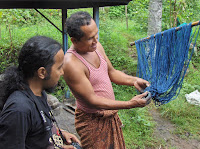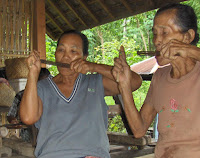Fiber Face 3 has given us the opportunity to show our
Rangsa ni Tonun film three times.
The first time was 12 February when Batak was chosen as the theme of the grand opening of Fiber Face 3. It was a very busy night -- the busiest that Fiber Face 3 has had to date -- with people lined up to the street to get in and all of the chairs taken. We don’t know how much this had to do with the Batak community coming out in full force. If they came, I think they went away satisfied. We had a full Batak gondang orchestra with the two brilliant players Marsius, amazing with his flute, and Sarikawan Sitohang mastering all of the instruments.
 |
Sarikawan and Marsius Sitohang are wearing the red headcloths.
The set of drums was owned by Batak in Yogyakarta. The musicians
were thrilled to play with the talented Sitohang brothers.
(Photo MJA Nashir) |
Mas Nashir orchestrated the opening performance. He had Ompu Okta doli (the male counterpart) recite the Rangsa ni Tonun text to the Sitohang musical accompaniment as the prelude to the premiere screening of our film.
 |
Ompu Okta doli is reading his text while his wife, Ompu Okta boru, weaves
during the opening of Fiber Face 3 in Yogyakarta, February 2011.
(Photo MJA Nashir) |
Afterwards we heard that the people who had been able to see it enjoyed the film but that many others were unable to see it because of the milling crowds. I personally felt pleased enough with the result that Nashir had prepared for this big deadline, but was aware that we haven’t yet finished our polishing; there is still plenty of work to be done.
After the opening, my brother (son of my sister in the Hutabarat clan), the protestant minister, Bonar Lumbantobing, contacted me to say that he could be in Yogya on the 17th of February and would he be able to see if he came to Fiber Face 3? This was just the spark that we needed to prepare another screening. He came with a group of enthusiastic and thoughtful theology students. First I gave them a tour of the Batak textiles in the exhibit, then showed the film.
 |
Ito Bonar Tobing's class watching Rangsa ni Tonun on the television screen
in Taman Budaya where the Fiber Face 3 exhibition was staged
(Photo MJA Nashir) |
It was followed by a discussion about culture and religion. What has been lost, why, what can be done about it? We talked about the goal of Fiber Face to stimulate an awareness of the importance of indigenous textile techniques and the thought worlds wrapped up in cloth production.
This was a special moment for me. In Medan, ito Bonar had shared with me some of the insights he had gained from his explorations of Batak language. He had discerned, among other things, that Batak missionaries gave new denotations to Batak words that placed Batak culture in the light of their own European and Christian background and biases, a distortion, in other words, that often gave a negative twist to indigenous Batak beliefs. By discovering the real meanings of some of these Batak words ito Bonar has gained insight into the beauty of Batak culture. Such discoveries are powerful to a thoughtful, discerning mind such as his. I learned from the discussion that evening that the Batak church continues to question its relationship to indigenous Batak culture. So much has been lost that the students were scratching their heads. Why was it, again, that the church forbade so many elements of Batak culture? It all seems so innocuous today. Indeed, it is innocuous. There are essentially no spirit-worshipping Batak left and the culture has receded imperceptibly, like sand between the fingers. There is historical and cultural amnesia. Now the church perceives itself as a champion of Batak culture. Church leaders are asking themselves what they can do to rescue what remains.
 |
| (Photo courtesy Paulina Sirait) |
The evening was crowned by Paulina Sirait’s minutely documented review of the evening on Facebook. She was one of the students in attendance. (The photograph to the left is courtesy of Paulina Sirait. It was taken of us in front of two of the textiles in the exhibition from Muara..)
 |
| (Photo by Nelly Sitorus) |
Another showing was held for the general public on Saturday evening, the 19th of February. This was an important showing for Nashir because he invited his friends and colleagues from his past in Yogyakarta. He left Yogyakarta about a year ago to pursue his future and life in North Sumatra. The decision was preceded by a set of circumstances, not all of them easy, and when Nashir got up to talk about what the film meant for him, he was overwhelmed by all of the emotions that came flooding back. The viewing of Rangsa ni Tonun was an opportunity for him to bring his friends up to date with his life and his creative accomplishments. Several of his friends stood up to give testimony to his creative talents, his courage in searching for a new path for himself, and his good heart.
Others in the audience asked crucial questions:
How much of the weaving world that was shown is still alive and how much was staged?
How vibrant is the Batak literary tradition? Does it still exist? (Thankfully, there was awareness that we had filmed a piece of Batak literature and not simply made a documentary of Batak weaving techniques.)
What is the gendered division of labour in Batak weaving?
The themes of cultural transmission and cultural loss dominated the evening.
 |
Ompu Okta doli tells his story
about the very first ulos
(Photo by Nelly Sitorus) |
Our main stars, Ompu Okta boru and doli were in the audience. A highlight of the evening was when Ompu Okta doli stood up to talk about the origin and meaning of Batak ulos in Batak culture. He did so with his customary energy and narration skill transforming our space into a cozy Batak living room. Suddenly we were all grandchildren hanging on the lips of grandfather and culture was being transmitted from one generation to the next.
Much appropriate emphasis was placed on MJA Nashir’s single-handed filming, direction and editing of this film and he received some of the appreciation that he well deserves for his spectacular accomplishment. My job that evening was to present background issues related to the text and Batak ethnography.
I was sorry that there were some mix-ups and communication failures pertaining to our equipment just prior to the showing and we received a defective cable so that the colour red was absent from the film.
This evening, too, was crowned by Paulina Sirait’s
enthusiastic review in Facebook. (We are grateful for this because Nashir and I were both so keyed up with our participation that we forgot to use our cameras.) She has attended all three viewings and this time she brought a sizzling bevy of Batak beauties with her. The spirit of Batak women is indomitable! May they all take up weaving!

























